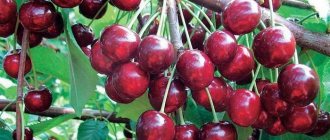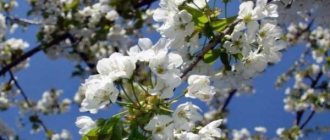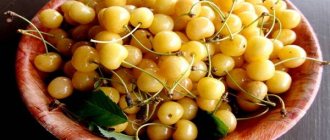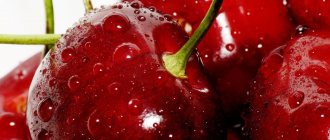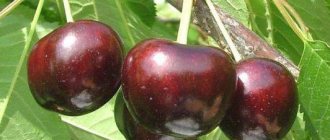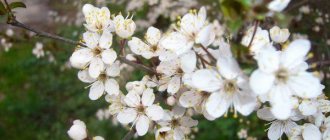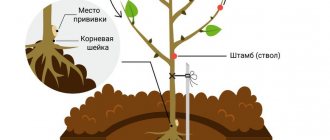The Orlovskaya Pink cherry variety is the result of domestic selection; the variety was bred by free pollination of the People's cherry. The hybrid type is listed in VNIISPK, the largest organization in the Russian Federation engaged in the study of berry and fruit crops and the development of gardening activities.
The variety was included in the state register in 2010. It is recommended to grow a fruit tree in the Central Black Earth region. To successfully grow cherries, you need to become familiar with all the features of planting, care, and prevention of diseases and harmful bugs.
Photo and description of the Orlovskaya pink cherry variety
Refers to varieties of medium ripening period. The crown is flat, pyramidal in shape, moderate foliage, bark color is gray. The branches are straight and brown. The leaves are oval, dark green in color, with a pointed base and apex. Flowers with a diameter of 22 mm are collected in inflorescences of 4 pieces. White petals are arranged freely.
Description of the fruits of the Orlovskaya pink variety:
- fruit weight 3.5-4 g;
- round shape;
- dimensions 17x17x18 mm;
- pink color;
- the pulp is juicy and of medium density;
- sweet and sour taste;
- the juice has no color;
- The oval yellow stone comes away from the pulp well.
Tasting assessment of fruits – 4.4 points. When removed from the stalk, no juice is released. The variety is used for dessert purposes and is suitable for homemade preparations.
Mature tree height
The Orlovskaya pink cherry variety is a medium-sized tree, reaching 3.5 m.
Flowering and ripening period
Flowering from the second decade of May. Ripe fruits begin to be harvested in mid-July. The first fruiting occurs in the 3rd year. Cherries ripen on bouquet branches and last year's growth.
Productivity
From 1 hectare of plantings, an average of 68.9 centners of fruits are collected, the maximum figures are 107.2 centners. During variety testing, the average yield per tree was about 10.3 kg.
Transportability
Due to the average density of the pulp, the Orlovskaya pink variety does not withstand long transportation. It is recommended to find a use for the fruits immediately after collection.
Drought resistance
Drought resistance is average. The variety is watered according to the standard scheme, preventing the soil from becoming waterlogged and completely drying out. You can learn more about the Orlovskaya pink variety from the video:
Frost resistance
Orlovskaya pink cherry has increased frost resistance. Fruit buds tolerate cold weather well. In autumn, the plant needs to be prepared for winter.
How to plant Orlovskaya pink cherries
The culture is demanding on the place of cultivation. Before planting, it is important to choose a high-quality seedling and prepare the soil.
How to choose a seedling
Cherry seedlings are purchased from nurseries. Annual plants do best. Planting material is assessed visually for the absence of damage, rotten areas, mold and other defects. The optimal length of a seedling is up to 1 m. It should have one powerful conductor and several shoots. If the roots of the tree are dry, they are kept in clean water.
Planting dates and scheme
In the southern regions, cherries are planted in the fall, when the leaves stop falling. 3-4 weeks before the cold snap, the seedling will have time to take root. In the middle zone, planting is postponed until spring, when the snow melts and the buds begin to swell. For cherries, select an area away from apple, plum and other large trees. The culture prefers fertile, loose soil and good lighting.
Pit preparation
The pit is prepared 1-2 months before planting the cherries. If the work is planned for spring, the pit is dug in the fall. This period is necessary for soil shrinkage.
Boarding order:
- First, a hole with a diameter of 0.7 m is dug to a depth of 0.6 m.
- A metal or plastic stake is driven into the center.
- To fill, use fertile soil, 2 buckets of rotted manure and 450 g of wood ash.
- The pit is left for the soil to shrink.
- Before planting the cherries, a small mound of soil without fertilizer is formed in the hole. The seedling is placed on top, the roots are covered with fertile soil and compacted.
- The seedling is tied to a support and watered. The soil is mulched with humus.
If you want a big harvest of cherries, plant them in pairs
— I decided to plant cherries, but I was completely confused about the varieties. For example, the variety “Gascinets” is partially self-fertile, and “Syubarovskaya” is self-sterile.
Do I understand correctly that a self-fertile variety needs a pollinator in the form of a self-fertile variety? That is, do you need to plant two seedlings at once or not? And also tell me, when is it better to plant cherries - in autumn or spring - and why?
— When cultivating fruit crops, and in particular stone fruits, the gardener is often faced with one unpleasant feature - the problem of self-fertility (the ability of a plant to fertilize itself), which affects the size of our harvest.
It is necessary to clearly understand that if a variety is self-sterile, it means that it is completely unable to pollinate itself with its own pollen and produce a crop.
Therefore, when growing such a capricious crop as cherries on your plot, regardless of whether the variety is self-fertile or partially self-fertile, planting and selecting a pollinator to obtain high yields is a mandatory agrotechnical technique. For the main cherry varieties of Belarusian selection, the following pollinating varieties are optimal:
- Variety
- Self-pollinating ability
- Best pollinators
- Gronkavaya
- self-sterile
- Folk, Beauty, Zhurba
- Gorgeous
- partially self-fertile
- Northern, Zhurba
- Syubarovskaya
- self-sterile
- Gronkavaya, Folk, Northern
- Knight
- self-sterile
- Northern, Amber, Iput, Gascinets
- Gascinets
- partially self-fertile
- Folk, Gronkavaya, Zhurba
- Lungwort
- self-sterile
- Northern, Amber, Iput, Gascinets
- Folk
- partially self-fertile
- Northern, Zolotaya Loshitskaya
- Pleasure
- self-sterile
- Northern, Yantarnaya, Iput, Ovstuzhenka
- Northern
- self-sterile
- Folk, Syubarovskaya, Muscatnaya
- Rival
- self-sterile
- Iput, Gascinets, Gronkavaya, Amber
Of course, to get a good harvest, it is better to buy the variety you like along with the optimal pollinator, especially since, as can be seen from the table, pollinators are, as a rule, also very good varieties with tasty fruits. One way to save space on your plot can be to graft cuttings from a recommended pollinator into the crown of your chosen variety.
Stone fruits are best planted in the spring.
April is optimal, but every year you need to be guided by the prevailing meteorological conditions: choose a period with sufficient soil moisture and the absence of the possibility of return frosts. However, if you have a good cellar with the ability to dig up seedlings for the winter, you should not be afraid to buy planting material in the fall.
Caring for Orlovskaya pink cherries
To obtain a high yield, it is important to provide the cherries with the necessary care. During the season, the tree is watered and fed with useful substances. Using pruning, the crown is formed.
Feeding and watering
Cherries begin to be fed a couple of years after planting. If fertilizers were applied to the pit, then their supply is sufficient for the development of the seedling. In the future, fertilizing is carried out annually. The culture reacts positively to the supply of nitrogen substances. In early spring, it is watered with an infusion of cow manure or a urea solution (30 g per 10 liters of water). At the beginning of fruiting, prepare a solution of superphosphate and potassium salt (30 g of each component per 10 liters of water). In the fall, dig up the soil and add 10 kg of compost, 90 g of phosphorus and 40 g of potassium fertilizer.
Cherry is a moisture-loving crop that is watered 3-4 times per season. 5 buckets of water are added to young trees; adults need up to 12 buckets. Trees need moisture when buds open, before fruiting, and in the fall during preparation for winter.
Weeding and loosening
After watering, loosen the soil so that moisture does not stagnate in the soil. As a result, the soil is saturated with oxygen, and cherries better absorb moisture and minerals. The soil is loosened to a depth of 10-15 cm. Be sure to clear the tree trunk circle of weeds.
Crown formation
Pruning helps stimulate the growth of new strong shoots and produce high yields of cherries. It is carried out in spring or autumn, when the sap flow of the cherry slows down. The Orlovskaya variety forms a tiered, sparse crown. The process takes about 5-6 years. Each tier consists of 3-5 shoots located at a distance of 15 cm. The remaining branches are cut out. About 50 cm is left between individual tiers. In total, it is enough to form 3-4 such tiers. Every year, preventative pruning is carried out: old, dry, frozen and diseased shoots are removed. The top is trimmed to a height of 3.5 m.
Pollinators of the Orlov pink cherry
The variety Orlovskaya rosea is self-sterile. A prerequisite for obtaining a harvest is the presence of pollinators. They are planted at a distance of 3-4 m from each other. For the formation of ovaries, it is necessary that the trees bloom at the same time. It is recommended to choose zoned varieties. For example, the Orlovskaya Amber cherry with yellow fruits is suitable for planting in the middle zone.
Best pollinators:
- Poetry. The dessert variety ripens in the middle period and bears dark red fruits. The flesh is gristly, sweet and sour. The variety is relatively resistant to fungal diseases and winter frosts.
- Pink pearls. Large-fruited variety, average weight of cherries is 5 g. The fruits are pink-orange with a red tan. The taste is sweet, the yield is stable. Sweet cherries are little susceptible to fungal infections.
- In memory of Chernyshevsky. A tall, fast-growing tree that bears rich red fruit. The pulp is tender, sweet and sour, taste rating is 4.8 points. Winter-hardy variety with high yields.
- Orlovskaya Amber. A cherry variety with good yield and resistance to coccomycosis. The fruits are large, sweet, yellow in color.
Characteristics
The amber variety tolerates heavy rains and drought well, and the fruits do not crack. Due to the original color of the berries, cherries are protected from bird attacks, which leads to the preservation of the fruits on the plant.
Drought resistance, winter hardiness
The variety is characterized by such important qualities as resistance to frost and prolonged lack of watering. Thanks to the frost resistance of the Amber cherry, the variety will not die and will bear fruit stably even after frosts down to -30 °C.
It is recommended to water Amber once a month. After the dry season, the plant must recover, so watering is increased to once a week. Both standing water and running water are suitable.
The video will tell you about other features of yellow-fruited cherries:
Pollination, flowering period and ripening time
The Yantarnaya variety cannot pollinate on its own. Along with it, other plants are planted that will perform this function.
The following varieties are suitable as pollinators for Amber cherries:
Cherry ovaries appear after pollination and form within a month. They come with a pointed end and are shaped like a heart.
The ripening of fruits on the plant occurs quite quickly; the berries of this variety are located in bouquets on “legs” and are easily separated.
Productivity, fruiting
According to the description of the Oryol Amber cherry in various sources, it does not begin to bear fruit immediately. The plant takes about 4 years to become strong. During the harvest period, the variety usually produces 35 t/ha per year. This is considered average for commercial use. In private gardens, this amount of fruit is more than enough.
To get a rich annual harvest from cherries, you need to follow the rules of care.
Area of application of berries
Yantarnaya berries are mainly eaten unprocessed, enriching the body with vitamins and minerals. Cherries are good for maintaining health:
- serves as a prevention of various diseases;
- improves blood composition;
- normalizes digestion.
You can also cook compotes from cherry fruits, make preparations for the winter: preserves, jams, jellies, confitures - and add fresh or frozen berries to baked goods.
Thanks to its beneficial properties, cherries have also found application in cosmetology. Masks made from the juice and pulp of Amber berries slow down aging and improve skin quality.
Resistance to diseases and pests
Oryol amber cherry is resistant to rust and coccomycosis. However, some diseases can damage the crown and lead to complete death of the variety.
The plant may be affected by cylindrosporiosis infection. The disease is of fungal origin. Infection occurs through the wind. All above-ground parts of this cherry variety are affected. The disease manifests itself as spots on the leaves, in the place of which holes subsequently form.
The most common insect that interferes with the growth of Amber is the cherry fly.
To prevent it from laying its larvae, for preventive purposes, Amber cherries are sprayed twice according to a certain pattern:
- When the air warms up to 18 ºC and the flies just appear.
- in 10–15 days.
Other cherry pests:
They slow down growth and damage the bark and shoots.
Advantages and disadvantages
The plant has many benefits. The attractive characteristics of the Yantarnaya cherry variety include:
- frost resistance;
- regular fruiting;
- immunity to coccomycosis;
- resistance to fruit cracking;
- protection of the plant from sparrows and tits;
- exclusion of gray rot infection;
- ease of care;
- earlier maturation.
However, the Orlovskaya Yantarnaya cherry variety also has weaknesses.
Disadvantages of this type:
- requires pollination by neighboring plants;
- yield value is within the average;
- not suitable for areas with harsh winters.
Diseases and pests of Orlov pink cherry
The variety has average resistance to moniliosis and coccomycosis. These are fungal diseases that develop in dense plantings, during cold spells and frequent precipitation. Moniliosis leads to rotting of fruits, drying of shoots and flowers. Gray spots containing fungal spores appear on plants. Coccomycosis looks like reddish spots that grow quickly. As a result, cherry leaves fall off prematurely. To combat diseases, Bordeaux mixture, copper sulfate, Horus or Abiga-Pik are used.
Important! When ripening cherries, chemicals are used with caution. Spraying is stopped a month before harvest.
Various pests damage cherries: aphids, sawflies, and cherry flies. The insecticides Karbofos, Actellik or Confidor are used against them. Good prevention is whitewashing the trunk, digging up the soil, and sanitary pruning of shoots. An effective folk remedy is a solution of tobacco dust (0.2 kg per 10 liters of water) and liquid soap. They spray plantings at any time of the year.
Growing Tips
If you select winter-hardy varieties, plant cherries in a place favorable for them, carefully care for them, protect them from pests, and carry out disease prevention, it is quite possible to harvest a harvest of sweet and aromatic berries even in the North-West.
Fertilizer
Since minerals are poured into the hole when planting cherries along with humus, the tree is fed for the first time after a year or two. In the spring, water with diluted rotted manure or fertilize by dissolving 2 tbsp in a bucket of water. spoons of urea.
When flowers appear on the cherry tree, add potassium salt with superphosphate in liquid form. Once every three years, the soil in the tree trunk circle is dug up and compost or humus is incorporated into the soil.
Trimming
In the spring, 3 weeks after planting the tree, the side branches and top are shortened by half. The central trunk is made 20 cm longer than the other shoots. The cherry tree has a crown of 2 or 4 tiers, consisting of 3 branches. Every year, weak growths are cut out and dry and broken shoots are removed.
Diseases and pests
Varieties bred for cultivation in cool climates are immune to viruses, but in wet weather they are affected by fungi that cause hole spotting and gray rot. To prevent the activation of pathogenic microorganisms, after flowering the trees are sprayed with Bordeaux mixture or copper sulfate. The second processing begins by collecting the berries.
To prevent hole spot in early spring, cherries are sprayed with Nitrafen.
Stone fruits growing in the cool climate of the Northwest are subject to attack by:
- sawflies;
- leaf roller;
- cherry flies.
To cope with harmful insects, in early spring and several more times the trees are sprayed with insecticides - “Iskra”, “Aktellik”, and treated with “Karbofos”. Nets, stuffed animals, and shiny disks that hang on trees help protect the berries from starlings and sparrows.
Harvest rationing
In the Leningrad region, the fruits of stone fruit crops do not always have time to ripen. To speed up the ripening of cherries, cut off the excess ovary. The first flowers that appear on young plants are completely removed.
How to choose seedlings
When buying a tree to grow in your summer cottage or yard, you need to carefully consider it. You need to purchase cherries with a smooth, even trunk and root collar without damage. The leaves should be free of stains, plaque, and traces of insects. It is necessary to buy fruit trees that are adapted to the local climate.
